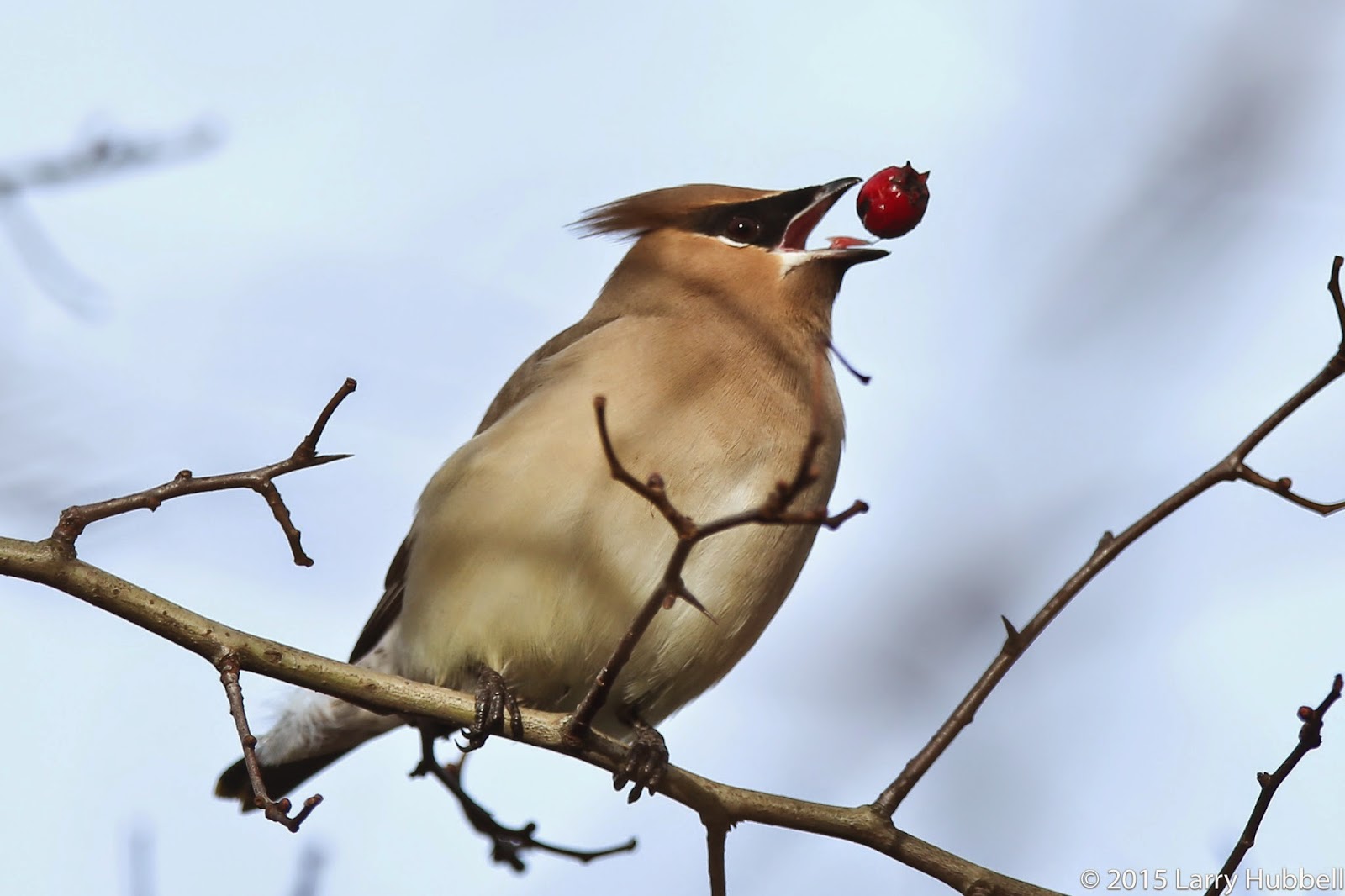Cedar waxwings are one of my favorite birds. I am not sure whether it is the combination of subtle and yet striking coloring, their inquisitive personalities, their communal nature, their constantly changing crests or their tendency to eat brightly colored berries, that makes them most attractive.
Their black masks are certainly an eye catcher. It can be easy to miss the thin white border that elegantly outlines their masks. I think the masks help give the impression that their beaks are somewhat large, when in fact, they are fairly small.
Waxwings have a confidence and presence that seems larger than their physical size, maybe that is part of their attractiveness.
At the most, they are only one inch longer than a house sparrow and they both weigh about one ounce.
Sometimes, the berries are just a bit too big and they pop out of the waxwing's mouth.
This waxwing seems to be wondering, "Did anybody see that?" Often when the berry slips a waxwing will reach out and pluck it out of mid-air.
But even if that fails to work, the waxwings never leave their perch to search for the fallen berries.
Maybe if there were less berries they would be more motivated.
While sitting on a single perch, the waxwings will often eat a half a dozen berries in rapid succession.
The underside of the bird fades subtly from tan to yellowish and then to white under the tail. Did you notice how the rounded area below the "chin" is perfectly shaped to allow the berry to pass down the throat?
Working together side by side or sitting together in the sun is all part of the waxwing community or flock behavior.
This bird seems to be wondering if the last berry on the branch is worth the effort. Are they actually smart enough to do that type of careful calculation?
…maybe one day we will find that waxwings are surprisingly smart.
Have you wondered how the waxwing got its name? If you look closely you can see small "waxy" protrusions of red just above this bird's tail. These "wax drops" grow from their secondary wing feathers and provide the inspiration for the name, waxwing.
Not all waxwings have the red "wax" on their wings. There are no red wax drops on this bird but you can see where the secondary feathers are located. The primaries are the eight largest wing feathers that are furthest from the bird's head. Between the primaries and the bird's body are the secondaries. (Not surprisingly, the wing feathers that cover the tops of the primaries and the secondaries are called the coverts.)
When the wings are folded the secondaries lay on top of the primaries. The waxy tips on the end of the secondary feathers point towards the terminal tips of the primaries. On the Cornell site, All About Birds, they say, "The exact function of these tips is not known, but they may help attract mates." It seems an unlikely coincidence that the waxy tips and the berries have similar colors. We still have a lot to learn about all the creatures that live around us.
Again the berry starts to slip away.
A diving catch brings it back for another try. (The top of the bird's head is nearly aligned with the division between the primary and secondary wing feathers.)
The bird seems to think, "Maybe if I squish it just a bit."
"Maybe if I open my mouth just a little wider."
But…
…no...
…it is still too large.
The berry pops out again before...
…it finally goes down the hatch.
A closer examination shows a notch in the tongue and two sharp points that are clearly the "points of no return" for the berries. Two weeks ago we saw a similar design in the tongue of the varied thrush. It makes me think, humans didn't really invent the concept of a fish hook, we just borrowed it from Mother Nature.
My hope is that if we pay more attention to nature we will realize the beauty and elegance of these creatures and also how much influence we have on their existence. By planting native mountain ash in your yard you can increase the odds of cedar waxwings stopping by for lunch. By driving less and eating less meat we can help slow global warming, hopefully before we pass the point of no return.
Clarification:
This week Harsi, a very kind and faithful reader, noticed that I failed to mention the source of the extra color in last week's photos.
Harsi knew the photos were taken on Montlake Cut and she correctly surmised that I would not add color to my photos after the fact. With these clues she found the following link that shows some of the loyal student graffiti along The Cut.
Harsi also pointed out that the comment "Go Duck Hunting", seemed appropriate, given that I hunt with a camera.
Thank you, Harsi!
Have a great day on Union Bay…where nature lives in the city!
Larry
For the Record:
The waxwings were not intimidated by the robins even though they are two and half times heavier than the waxwings.
On the other hand, when this crow landed above the waxwings, they flew a short distance and waited until the crow flew away.

































Fantastic post, Larry!
ReplyDelete